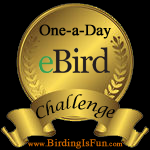Today I spent a beautiful morning out at Boa Ogoi (Shoshone:Big River AKA Bear River) with Darren Parry, a member of the Northwestern Band of the Shoshone Nation tribal council. We visited the site of the Bear River Massacre north of Preston, Idaho--where a US Army detachment attacked and massacred over 250 Shoshone men, women, and children at a winter village in 1863.
 |
| Daughters of the Utah Pioneers Bear River Massacre monument, Highway 91 north of Preston, ID |
When I arrived at the
Daughters of the Utah Pioneers (DUP) monument to the massacre on Highway 91, the most obvious birds were the non-native
Rock Pigeon, European Starling, House Sparrows, and most recent new colonizer the
Eurasian Collared-Dove. I wondered if it was fitting, or ironic? But listening closely, the native birds were still there as well--a
Killdeer (Duck Valley Shoshone:
pantei) piped up from a nearby horse pasture. A
Yellow Warbler flew into the trees behind the monument and interpretive sign. A couple of
Yellow-headed Blackbirds flew around the marsh, and two pairs of
Sandhill Cranes (Duck Valley Shoshone:
koanta) seemed to call to each other from opposite sides of the highway.
White-faced Ibis and a lone
Mallard (Duck Valley Shoshone:
peye) flew over. Darren and I visited for awhile, and as we prepared to get in our cars, a pair of
Red-tailed Hawks circled over a nearby field (
eBird checklist with complete list of 16 species and coordinates)
 |
| One of six beautiful interpretive signs up the road from the DUP monument. |
 |
| Picnic tables and interprerive signs up the road from the DUP monument |
 |
| Memorial for the children killed during the massacre |
We drove up the road a few hundred yards to a much more informative collection of interpretive signs installed by the state of Idaho with Shoshone input. It was more quiet up on this bench overlooking the valley, and a Swainson's Hawk watched us from a nearby fencepost (eBird checklist).
 |
| Roadside hot spring on the Northwestern Band of the Shoshone Nation land at Boa Ogoi |
Several hot springs dot the landscape, and were an important feature making this a good wintering village site for the Shoshone. We drove down the river valley a ways to one set of bubbling and steaming springs right near the road. A miniature Yellowstone. Along one hillside, a roadbank was pocked with
Bank Swallow nesting holes, and almost two dozen swallows circled and swooped in the vicinity (
eBird checklist).
For a contemporary Shoshone take on the Bear River Massacre, you can get Darren Parry's book--The Bear River Massacre: A Shoshone History--with notes on traditional Shoshone foods, prayers, life ways, and more recent history.
The Shoshone--who traditionally refer to themselves as Newe ("the People")--continue to be active at this massacre site. The Northwestern Band of the Shoshone Nation aquired over 700 acres along the river, including the massacre site, and are planning to build the Wuda Ogwa Cultural & Interpretive Center there. They have raised over $6 million of a required $8+ million (donate here) for construction, and are also conducting a multi-million dollar habitat restoration program on this land, including removing thousands of invasive Russian olive trees. Hopefully Boa Ogoi will continue to host its traditional human inhabitants, as well as its native wildlife (referred to as "our non-human kin"), for the forseeable future and until the end of time.
For more information:
The Bear River Massacre: A Shoshone History (book by Darren Parry)
Darren Parry's work with the Environmental Humanities Graduate Program at the University of Utah
2018 Salt Lake Tribune article on culture center plans
PBS video on ecological restoration at Boa Ogoi
Wuda Ogwa Cultural & Interpretive Center (information and online donation page)
Shoshoni Language Project



_Peten.jpg)












